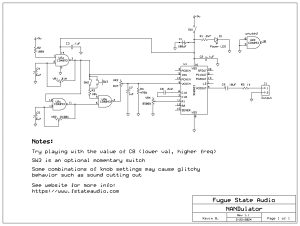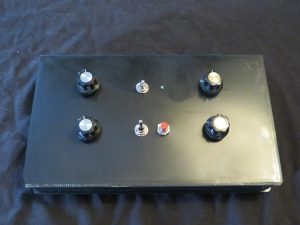NANDulator is a simple, lo-fi, CMOS-based noisemaker synth. It uses two IC’s, a CD4093 (quad NAND gate) and a CD4046 (VCO/phase-locked loop), and a handful of passive components. I think it’s simple enough to work as a beginner’s project, and there’s also room for modification/hacking.
Audio demo:
Schematic:
What’s basically going on:
Two of the NAND gates are set up as simple oscillators, with their frequencies controlled by pots VR1 and VR2 (see the TrigPulser Mini page for more info on how these work). The output of the first oscillator is also fed into one of the inputs of the second oscillator’s NAND gate, and can also optionally be sent to one of the inputs of the third NAND gate, which is also fed by the second oscillator. Note that the fourth NAND gate is unused, and as per best practice, the inputs are grounded.
The first oscillator is also feeding into the INH input of the CD4046, providing a sort of amplitude modulation. With component values as shown on the schematic, it goes from a slowish LFO chop into audio rates. The VCO input of the 4046 is fed by the output of the third NAND gate. The amount of modulation for this input is controlled by VR3, and VR4 controls the frequency offset of the VCO. As noted on the schematic, C8 also affects the frequency of the VCO.
This circuit could definitely be described as “wonky,” and isn’t necessarily using the 4046 the “right way.” However, it can also make some interesting sounds.
Demo video:
NANDulator: a wonky, lo-fi DIY noise synth
NANDulator is a simple, lo-fi, CMOS-based noisemaker synth. It uses two IC’s, a CD4093 (quad NAND gate) and a CD4046 (VCO/phase-locked loop), and a handful of passive components. I think it’s simpl…

